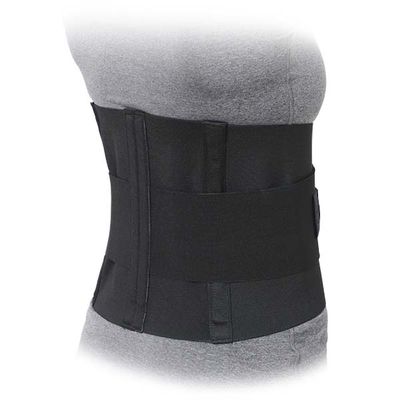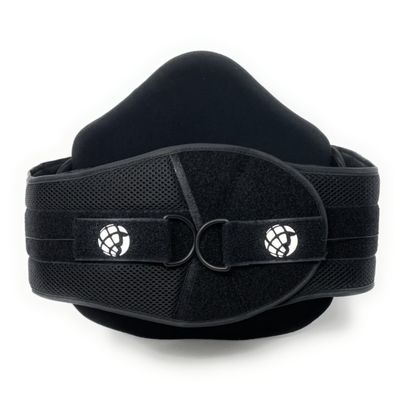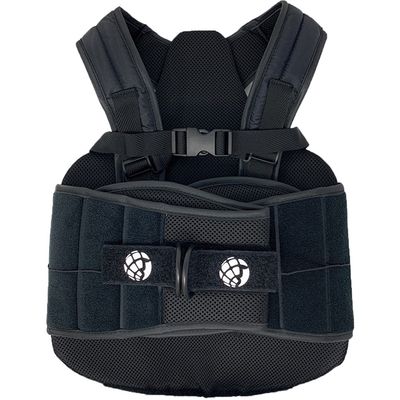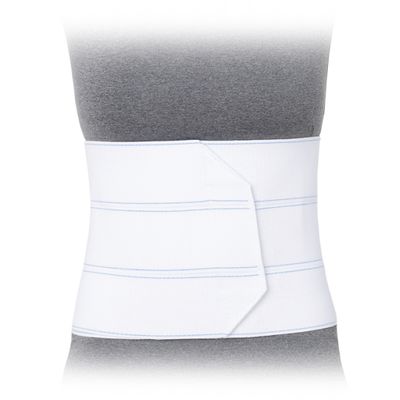
Thoraco-Lumbar Spine Brace
With Side Pulls

Lumbar Sacral = Back Support W/ Side Pulls
Lumbar Sacral = Back Support W/ Side Pulls
X-Small thru 5X Large
$68.00
Display prices in:USD
Table of Contents
Abdominal Belt / Binder / Support
An abdominal belt, also known as an abdominal binder or compression belt, is a wide band of elastic material worn around the abdomen to provide support, compression, and stability to the abdominal region. These belts are often used for medical, post-surgical, or cosmetic purposes and can help manage various conditions, including muscle strain, post-pregnancy recovery, or abdominal surgery.
Uses of an Abdominal Belt
Post-Surgical Recovery
- Purpose: Supports the abdominal muscles and tissues after surgeries such as hernia repair, C-sections, abdominal liposuction, or general abdominal surgeries.
- How It Helps: By providing compression, the belt reduces the risk of post-surgical complications, such as swelling (edema), fluid buildup (seroma), and incisional hernias. It can also help in reducing pain by stabilizing the surgical site and promoting healing.
Hernia Support
- Purpose: Supports the abdominal wall to prevent the protrusion of abdominal contents through weak muscles (such as in cases of an abdominal hernia).
- How It Helps: The belt compresses the hernia site and helps prevent further protrusion or worsening of the hernia, offering temporary relief until surgery or as part of long-term management.
Postpartum Support
- Purpose: Helps new mothers support weakened abdominal muscles and tissues after childbirth, particularly after a C-section.
- How It Helps: It provides compression, helps the uterus return to its pre-pregnancy size, reduces swelling, and aids in pain relief by stabilizing the abdomen.
Abdominal Muscle Strain or Injury
- Purpose: Used to support the abdominal muscles after a strain or injury.
- How It Helps: The belt reduces the movement of the abdominal area, allowing strained or torn muscles to heal faster by minimizing unnecessary stretching or stress.
Weight Loss and Slimming
- Purpose: Used by individuals aiming for temporary compression and slimming of the abdomen.
- How It Helps: The belt provides a “tucked in” appearance, offering a temporary slimming effect. Some people use these belts during exercise, believing that it can increase sweating and assist in weight loss, although the effectiveness of this approach is debated.
Post-Liposuction or Cosmetic Surgery
- Purpose: Provides compression to the abdominal area after liposuction or other cosmetic procedures to shape the abdomen.
- How It Helps: Compression helps reduce swelling, improves circulation, and aids in the proper contouring of the abdomen during the recovery process.
Lower Back Support
- Purpose: Offers additional support to the lower back, particularly in cases of lower back pain or lumbar spine problems.
- How It Helps: The compression around the abdomen provides indirect support to the lower spine, reducing strain on the back muscles and improving posture.
Types of Abdominal Belts
- Elastic Compression Belts:
- Design: Made from stretchy, breathable materials like elastic, spandex, or nylon. These belts provide firm compression and are adjustable with Velcro or hook-and-loop closures.
- Common Uses: Post-surgery, postpartum recovery, and weight loss support.
Postpartum Girdles
- Design: Similar to compression belts, but designed specifically for postpartum women. These girdles offer more coverage and compression in the abdomen and pelvic areas.
- Common Uses: Postpartum recovery and support of weakened abdominal muscles.
Hernia Belts
- Design: Typically includes extra padding or a support pad at the hernia site for targeted compression.
- Common Uses: Support for abdominal hernias (inguinal, umbilical, or ventral).
Surgical Abdominal Binders
- Design: These are wider than standard compression belts and offer firmer support, specifically designed for patients recovering from abdominal surgeries.
- Common Uses: Post-surgical support and pain management.
Corset-Style Abdominal Binders
- Design: Resemble traditional corsets with lace or hook fastenings, providing compression and shaping around the waist.
- Common Uses: Often used for cosmetic reasons or post-surgical shaping, such as after liposuction.
Benefits of Using an Abdominal Belt
- Compression and Support:
- Provides targeted compression to reduce swelling, promote healing, and support the abdominal muscles and tissues.
Pain Relief
- Helps in reducing discomfort and pain, particularly after surgery, childbirth, or injury, by stabilizing the abdominal region and limiting movement.
Improves Posture
- Many abdominal belts offer support that helps improve posture, reducing strain on the back muscles and spine.
Prevents Surgical Complications
- Reduces the risk of hernias, fluid buildup, or poor healing by keeping the abdominal tissues stable during recovery.
Aids in Mobility
- Post-surgical patients or those with abdominal injuries often benefit from an abdominal belt, as it provides support and allows them to move more comfortably during recovery.
Considerations When Using an Abdominal Belt
Fit and Comfort
- A well-fitting belt should be snug but not too tight. A belt that is too tight can restrict blood flow and cause discomfort, while one that is too loose may not provide adequate support.
Duration of Use
- Abdominal belts should typically be worn for limited periods, depending on the condition and the recommendation of a healthcare provider. Overuse can lead to muscle weakening if the belt is relied upon too heavily.
Material
- Choose breathable, comfortable materials to avoid skin irritation, especially when the belt is worn for extended periods.
Medical Guidance
- It’s important to use an abdominal belt under the guidance of a healthcare professional, especially post-surgery or for hernias, to ensure that the belt is providing the correct level of support and not causing complications.
In conclusion, abdominal belts are versatile and beneficial for various medical and cosmetic purposes, offering support and compression to the abdomen and lower back. They should be used according to medical advice, and proper fitting is crucial for effectiveness and comfort.



